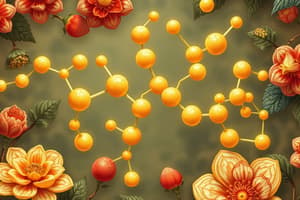Podcast
Questions and Answers
Which characteristic distinguishes biomolecules from inorganic compounds?
Which characteristic distinguishes biomolecules from inorganic compounds?
- Carbon-hydrogen covalent bonds (correct)
- Absence of carbon atoms
- Formation of electrostatic attractions
- Presence of ionic bonds
What occurs during capillary action in liquids?
What occurs during capillary action in liquids?
- Liquid flows through narrow spaces without external forces (correct)
- Liquid is pulled through external forces
- Liquid evaporates to increase pressure
- Liquid exhibits strict gravitational dependence
What determines the ability of water to dissolve various substances?
What determines the ability of water to dissolve various substances?
- Size of the water molecules
- Concentration of hydrogen ions
- Polarity of water molecules (correct)
- Presence of ionic bonds
In an ionic bond, which particles are primarily involved?
In an ionic bond, which particles are primarily involved?
Which statement correctly describes protons and neutrons?
Which statement correctly describes protons and neutrons?
What is the primary purpose of dehydration synthesis in biological molecules?
What is the primary purpose of dehydration synthesis in biological molecules?
Which of the following correctly distinguishes between saturated and unsaturated fats?
Which of the following correctly distinguishes between saturated and unsaturated fats?
What characterizes type 2 diabetes compared to type 1 diabetes?
What characterizes type 2 diabetes compared to type 1 diabetes?
Which statement about nucleotides is false?
Which statement about nucleotides is false?
Why are complex carbohydrates considered preferable to simple carbohydrates?
Why are complex carbohydrates considered preferable to simple carbohydrates?
What distinguishes carbohydrates from lipids in terms of their structure?
What distinguishes carbohydrates from lipids in terms of their structure?
Which elements are unique to amino acids compared to lipids and carbohydrates?
Which elements are unique to amino acids compared to lipids and carbohydrates?
During which physiological state is glycogen primarily released into the bloodstream?
During which physiological state is glycogen primarily released into the bloodstream?
Flashcards are hidden until you start studying
Study Notes
Dehydration Synthesis
- Two smaller molecules combine to form a larger molecule, releasing water.
Hydrolysis
- Water is added to a substance, breaking it down into smaller molecules.
Food Labels
- Carbohydrates provide 4 calories per gram.
- Protein provides 4 calories per gram.
- Fat provides 9 calories per gram.
- Saturated fats are solid at room temperature, while unsaturated fats are liquid.
- Carbohydrates on food labels include starches, sugars, and fibers.
Carbohydrates
- Chemical formula for monosaccharides: (CH2O)n.
- Examples:
- Monomer: Glucose
- Polymer: Cellulose
- Complex carbohydrates are digested slower and are higher in fiber, making them a healthier choice.
Lipids
- Elements: Oxygen, carbon, and hydrogen.
- Prevalent elements: carbon, hydrogen, and oxygen, with possible presence of phosphorus, nitrogen, sulfur, and others.
- Lipids have three different fatty acid tails.
- Compared to carbohydrates:
- Lipids have one glycerol and three fatty acids.
- Carbohydrates are classified as monosaccharides, polysaccharides, and disaccharides.
Diabetes
- Type 1 Diabetes:
- The pancreas doesn't produce insulin due to the immune system attacking insulin-producing cells.
- Type 2 Diabetes:
- The pancreas produces less insulin, and the body becomes resistant to its effects.
- Symptoms:
- Weight loss without trying.
- Increased hunger (polyphagia).
- Blurry vision.
- The liver and pancreas regulate blood glucose levels.
- Insulin Resistance:
- Muscle, fat, and liver cells don't respond effectively to insulin, hindering glucose uptake from blood.
- Excess glucose is stored in the liver and muscles as glycogen.
- When blood glucose is high, stored glycogen is released.
Proteins
- Contain four elements: carbon, hydrogen, oxygen, and nitrogen.
- Carbon is unique to proteins.
- Amino acids form peptide bonds.
- The diverse arrangement of amino acids leads to a wide variety of proteins.
- A polypeptide is a chain of many amino acids.
Nucleic Acids
- Contain carbon, nitrogen, oxygen, phosphorus, and hydrogen.
- Phosphorus is unique to nucleic acids.
Nucleotide
- Consists of a nitrogenous base, a pentose sugar, and a phosphate.
Biomolecules
- Organic compounds derived from or produced by living organisms.
- Have carbon-hydrogen covalent bonds.
- Inorganic compounds are derived from nonliving sources.
- Generally have ionic bonds and lack carbon-hydrogen bonds.
- Rarely contain any carbon atoms.
Water
- Capillary Action: Liquid flows through narrow spaces without external forces, such as gravity.
- Solute: The substance being dissolved.
- Solvent: The substance that dissolves the solute.
- Solution: The liquid mixture formed by a solute dissolved in a solvent.
- Water's polarity allows it to form covalent bonds with many substances, enabling it to dissolve a wide range of compounds.
Atoms
- Protons: Positively charged particles.
- Electrons: Negatively charged particles.
- Neutrons: Neutrally charged particles.
- Electrons enable atoms to bond together covalently or ionically.
- Ionic Bond: Electrostatic attraction between oppositely charged ions in a chemical compound.
Studying That Suits You
Use AI to generate personalized quizzes and flashcards to suit your learning preferences.




